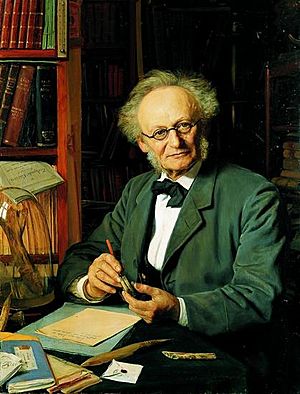Japetus Steenstrup facts for kids
Quick facts for kids
Japetus Steenstrup
|
|
|---|---|
 |
|
| Born | 8 March 1813 Vang, Thy, Denmark
|
| Died | 20 June 1897 (aged 84) |
| Resting place | Assistens Kirkegaard, Copenhagen |
| Alma mater | University of Copenhagen |
| Scientific career | |
| Fields | Zoology, Botany, geology, Archaeology |
| Institutions | University of Copenhagen, Denmark |
| Doctoral students | Hans Christian Gram |
| Influences | Joakim Frederik Schouw
Johannes Reinhardt Georg Forchhammer |
Johannes Japetus Smith Steenstrup (born March 8, 1813 – died June 20, 1897) was an important Danish zoologist, biologist, and professor. He made many discoveries in science, especially about how living things change and grow.
Contents
About Japetus Steenstrup
Japetus Steenstrup was born in Vang, Thy, Denmark, on March 8, 1813. He first taught about minerals in a town called Sorø. In 1845, he became a professor of zoology at the University of Copenhagen. He studied many different things in nature.
Discoveries in Biology
Steenstrup was very interested in cephalopods, which are sea animals like squids and octopuses. He also studied genetics, which is about how traits are passed down.
In 1842, he made a big discovery about something called the alternation of generations. This means that some living things, like certain worms, have different forms during their life cycle. They might look very different at different stages of their lives.
Studying Earth's Past
Steenstrup also found a way to learn about past climate changes. He used old plant and animal remains found in the ground. These remains, called subfossils, helped him understand how the climate and plants in an area changed over time. He called this process ecological succession, which is how living communities in an area change and replace each other.
Two of his students, Christian Vaupell and Eugen Warming, continued to work on these ideas.
His Students and Colleagues
Japetus Steenstrup taught many bright students. One of them was Johan Erik Vesti Boas, who also became a zoologist. Another famous student was Hans Christian Gram, who invented a special way to stain bacteria. This stain helps scientists see bacteria more clearly.
Steenstrup also worked with other famous scientists. He corresponded with Charles Darwin, who is known for his theory of evolution. Between 1846 and 1854, Darwin was studying barnacles, which are small sea creatures. Steenstrup sent Darwin information and barnacle samples from Denmark. Darwin was very thankful for Steenstrup's help. He even sent Steenstrup a box of 77 different barnacle species as a gift!
Other Achievements
Steenstrup helped publish Flora Danica fasc. 44. Flora Danica is a very old and important collection of drawings and descriptions of plants found in Denmark.
Because of his important work, Steenstrup was invited to join many famous scientific groups. In 1842, he became a member of the Royal Danish Academy of Sciences. Later, he was elected to the Royal Swedish Academy of Sciences in 1857 and the American Philosophical Society in 1862. In 1863, he became a member of the Royal Society, which is one of the oldest and most respected scientific groups in the world.
Japetus Steenstrup passed away in Copenhagen on June 20, 1897.
Images for kids
-
Japetus Steenstrup's gravestone at Assistens Kirkegård, Copenhagen


